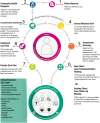FlourishCare Model of Integrated Care: The Validation of the Flourish Index-Revised
- PMID: 38721939
- PMCID: PMC11184524
- DOI: 10.1093/geront/gnae042
FlourishCare Model of Integrated Care: The Validation of the Flourish Index-Revised
Abstract
Background and objectives: This study validates the Flourish Index-Revised (FI-R), a tool evaluating integrated healthcare models. The original Flourish Index (FI) was developed in 2018 and has been refined to align with the FlourishCare (FC) Model (Model) for geriatric primary care.
Research design and methods: The Model provides integrated biopsychosocial healthcare to older adults. The FI-R uses 25 quality-of-care indicators and 7 contextual community indicators. The FI-R was validated with Categorial Principal Components Analysis (CATPCA) using a sample of 949 patients 50+ who were mostly female (73%), non-Hispanic White (70%), living in urban areas (90%), and married (29%), single (22%), or divorced (19%). The mean age was 73.46 (standard deviation [SD] = 10.86) and mean years of education was 14.30 (SD = 2.14).
Results: CATPCA showed a 4-dimensional structure of biological, psychological, and 2 social determinants of health (SDOH) subdomains: health behaviors and community. Final selection of indicators was based on total variance accounted for >0.30, absolute values of item loadings >0.45, and not having cross-loadings >0.45 on 2 factors. Internal consistency (Cronbach's alpha) for the determinants were biological = 0.75, psychological = 0.76, SDOH:community = 0.70, SDOH:health behaviors = 0.50, and total FI-R = 0.95. Sensitivity to change was shown for the total FI-R, psychological determinants, and SDOH:health behaviors, but not for biological determinants.
Discussion and implications: The validation of the FI-R shows promise for its usability to evaluate integrated healthcare models using existing measures in electronic health systems. More work is needed to improve the incorporation of SDOH:sociodemographics into the FI-R.
Keywords: Age-friendly healthcare; Analysis—categorical analysis; Biopsychosocial determinants of health; Integrated healthcare; Interprofessional teams.
© The Author(s) 2024. Published by Oxford University Press on behalf of The Gerontological Society of America.
Conflict of interest statement
None.
References
-
- Agency for Human Services. (2022). 2022 Blueprint for health annual report. https://blueprintforhealth.vermont.gov/sites/bfh/files/doc_library/2022%...
-
- Bandura, A. (1997). Self-efficacy: The exercise of control. W.H. Freeman and Company.


